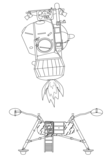 A standard LK | |
| Operator | Soviet Union |
|---|---|
| COSPAR ID | 1970-099A |
| SATCAT no. | 04760
|
| Mission duration | 12 years, 9 months and 27 days |
| Spacecraft properties | |
| Spacecraft type | T2K |
| Launch mass | 7,495 kilograms (16,524 lb) |
| Start of mission | |
| Launch date | 24 November 1970, 11:00:00 UTC |
| Rocket | Soyuz-L |
| Launch site | Baikonur 31/6 |
| End of mission | |
| Decay date | 21 September 1983 |
| Orbital parameters | |
| Reference system | Geocentric |
| Regime | Low Earth |
| Eccentricity | 0.004161 |
| Perigee altitude | 198 kilometres (123 mi) |
| Apogee altitude | 253 kilometres (157 mi) |
| Inclination | 51.6 degrees |
| Period | 88.7 m |
Kosmos 379 ( Russian: Космос 379 meaning "Cosmos 379") was an unmanned test of the LK (the Soviet counterpart of the Apollo Lunar Module) in Earth orbit.
Mission
Earth orbit simulated propulsion system operations of a nominal lunar landing mission. Kosmos 379 entered a 192 to 232 km low Earth orbit. After three days it fired its motor to simulate hover and touchdown on the moon, in imitation of a descent to the lunar surface after separation of the Blok D lunar crasher propulsion module. The engine firing changed its orbit from 192 km X 233 km to 196 km X 1206 km ( delta-V = 263 m/s).
After a simulated stay on the Moon, it increased its speed by 1.518 km/s, simulating ascent to lunar orbit making the final apogee 14,035 km. These main maneuvers were followed by a series of small adjustments simulating rendezvous and docking with the Soyuz 7K-L3. The LK lander tested out without major problems and decayed from orbit on September 21, 1983. [1]
Parameters
- Spacecraft: T2K
- Mass: 5500 kg
- Crew: None
- Launched: November 24, 1970
- Landed: Reentered September 21, 1983
- Orbit: 192 km
References
- ^ "Soyuz 11A511L". Archived from the original on December 27, 2016.
External links
- Mir Hardware Heritage
